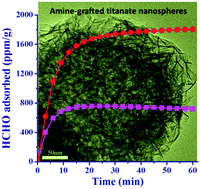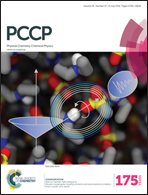Efficient removal of gaseous formaldehyde in air using hierarchical titanate nanospheres with in situ amine functionalization
Abstract
Removing formaldehyde (HCHO) in air by efficient and recyclable adsorbents is crucial for improving indoor air quality. Nanosized adsorbents with a higher surface area and abundant functional groups are highly desirable. In this report, hierarchical titanate nanospheres (HTS) were prepared as effective adsorbents by the diethylenetriamine (DETA) mediated one-pot solvothermal process. Typically, the HTS adsorbents were assembled by titanate nanosheets with abundant in situ grafted amine groups. Impressively, because of their hierarchical assembled structure, considerable specific surface area and pore volume, and abundant surface amine groups, the optimized HTS adsorbents exhibited excellent HCHO adsorption properties, with nearly 100% removal efficiency for HCHO in air at room temperature. Moreover, the recyclability of optimized HTS adsorbents is considerable, with only a very slight decrease in removal efficiency after 6 cycles. The DETA introduced into the synthesis system is crucial for both chemical and textural modifications of HTS adsorbents. Specifically, the DETA mediator not only affects significantly the phase, morphology, and textural properties of the obtained titanate products, but also induces in situ grafted surface amine groups. As a consequence, the adsorption capacity and recyclability of HTS adsorbents can be largely modified by adding different amounts of DETA to the synthesis system.


 Please wait while we load your content...
Please wait while we load your content...